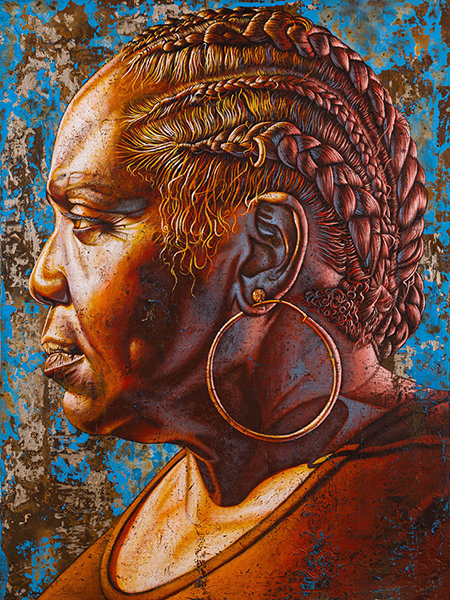
Continuing through March 4, 2023
A few years ago, a colleague pulled an impatient face when I mentioned figure painting. “What’s the point?” she said.
I couldn’t think of a rejoinder that captured my conflicted feelings without sounding defensive and the conversation moved on. But I’ve been pondering that question ever since.
Now, Alfred Conteh’s current work demands that I revisit the question. What is the point?
Conteh paints larger-than-life realist portraits of people he meets around Atlanta, his hometown. Nearly all his subjects are African American. He focuses on single figures and small groups, painting them in statis — a father and son, a trio of young friends, a young woman with a gun tucked into the waistband of her jeans. Before Conteh paints them, he interviews his subjects. He gets to know them and seeks to represent their lives and circumstances without telling explicit narratives (although sometimes he does provide intimate details about their lives in his artist’s statement, I presume with their permission). He wants us to know that most of his subjects are struggling. Their lives are hard and dangerous. More than one is packing, and the young woman with the gun in her jeans also wears a cross around her neck, for double protection.
Conteh renders these figures with impressive skill, paying old-fashioned attention to textured surfaces — fabric, hair and, particularly, flesh. The atomized bronze and iron powder he adds to his paint lends a weirdly sculptural gloss to the figures’ skin, which looks burnished and almost feverish, as if glowing from within.
“Shampoo” is a portrait of a middle-aged man who works part-time as a pimp, Conteh tells us, perhaps unwisely. He has long, luxurious hair and a philosophical gaze. Like most of Conteh’s figures, “Shampoo” is painted from a vantage point that places him above us. We have to lean back to look up at his face and our eyes first travel up the carefully rendered creases on his throat. The feeling is of being a child again, looking up at adults with all their blemishes. The daunting effect is not accidental. Any photographer or model will tell you the under-the-chin shot is the least flattering view. Conteh doesn’t spare us the details of aging skin, which lend his figures the authority of age and experience.
While there’s no flattery in these portraits, neither is there pathos or insult. If we hadn’t been told of the man’s business, we wouldn’t guess. His face is not cruel or hard. Except for the big medal on his chest, he could be someone’s favorite art teacher. He looks thoughtful, determined, unconventional. It’s impossible to divine what he’s thinking. He could be counting his money or thinking of some faraway place that has nothing to do with business.
It’s this openness to interpretation that makes Conteh’s work interesting, and the lack of it that makes much photorealism boring. His figures might be even more interesting without the biographical details he serves up in his statement.
In nearly all these paintings Conteh places his figures in this position of physical superiority. They are larger than you are, they loom above you, literally and, he implies, perhaps otherwise, too. They look down at us, we up at them. This safe distance protects them from us, and it makes you feel lesser. In this way, he regards the subjects of his paintings as giants of a kind, inspiring a range of reactions.
“Renee” is a head-and-shoulders profile portrait of a middle-aged or older woman. Her image is dominated by the elaborately braided head of hair and, at dead center, an ear pierced with two earrings, one of which is a giant hoop. Another gold ring appears looped into a braid. The woman’s hair and jewelry and the whorls of her ear are the stars of this painting. Obsessively attended to, especially the braids and the tendrils that escape them, the hair is painted as if it is a living organism or rows in a garden or a woven basket. Here on her head, we guess, is the woman’s art, her organizing principle. A great deal of work and design went into the making and maintenance of this hairdo. Likewise into its rendering, which is not photorealist but translates the real into a pattern verging on the abstract. As for the glowing vertical slice that is Renee’s face, she wears an expression that might be ferocity or sorrow. It could be belligerent resolve or simple concentration. But it looks, on a woman, like anger. Any woman can relate to that.
I could do without Conteh’s scumbled backgrounds. He says they’re meant to suggest the gritty, ruined environments his subjects inhabit. I get it, but they look more like decorating motifs of the faux-distressed variety, applied here as gimmicky finishing touches, neither intrinsic nor particularly felt. These figures deserve better, or maybe worse, but either way, something more than this facile fake “ruin.”
So, what does this show tell us about the point of figure painting? For Conteh it’s to explore his subjects’ humanity in a way that is complex and respectful, but unsentimental. In his best work, he succeeds.
